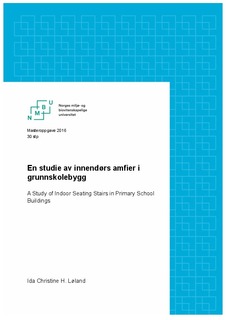| dc.description.abstract | De siste årene har vi sett en tendens til et økende omfang av innendørs amfier i norske grunnskoler. Med utgangspunkt i dette har denne forskningsoppgaven som mål å belyse hvilken rolle innendørs amfier har i skolene. Til forskningsspørsmålet følger det underspørsmål som har som hensikt å redegjøre for amfitrenden, ved å svare på når og hvorfor innendørs amfier inntok de norske grunnskolene, kategorisere ulike amfityper, og sammen benytte de innsamlede dataene for å kunne svare på spørsmålet ”Hva kjennetegner et godt amfi?”.
Gjennom en kombinasjon av kvantitative og kvalitative tilnærminger i en metodetriangulering, legges det til grunn et omfangsrikt datamateriale. De kvantitative metodene består av en innhenting av skoledokumentasjon som kartlegger 2442 grunnskoler i Norge, og en spørreundersøkelse utsendt til samtlige av disse skolene. Det kvalitative arbeidet består i hovedsak av skolebesøk hos ti utvalgte grunnskoler, og suppleres med dybdeintervjuer av to arkitekter.
Funn i denne oppgaven viser at den største brukergruppen av amfiet er elevene, etterfulgt av henholdsvis ansatte, kveldsgjester og foresatte. Videre er amfienes største bruksområde forestillinger, deretter informasjon, sosialt samlingspunkt og undervisning. Dette viser at amfiene er flerfunksjonelle konstruksjoner som kan brukes til ulike bruksområder og av ulike brukergrupper.
Videre viser spørreundersøkelsen at 68 % av rektorene mener at amfiet i deres skole innfrir forventningene. Samtidig sier 72 % at amfiet er en stolthet for skolen. 50 % av rektorene på skoler uten amfi ser behovet for en slik konstruksjon. Samtidig avdekker skolebesøkene at tiltak for sikkerhet og universell utforming er momenter ved amfiet som har fått lite fokus.
Resultatene tyder på at en amfikonstruksjon har en pedagogisk, sosial og estetisk rolle, utover å være en del av skolens infrastruktur. Samtidig er amfiet ofte en del av skolens identitet. Amfiene er et forholdsvis nytt fenomen innen skolebygging, og antall amfier har økt betraktelig de siste ti årene. Pådrivere for amfienes inntog og forankring er et resultat av flere faktorer som samfunnsutvikling, befolkningsøkning, skolelovgivning og pedagogisk og arkitektonisk utvikling.
Amfiene som har fremkommet av forskningsoppgaven varierer i størrelse, fasong, funksjon og formål. Ut fra dette deles de inn i fire kategorier: Samlingsamfi, sceneamfi, undervisningsamfi og trinnamfi. I tillegg til kategoriseringen kan hvert amfi deles inn i åpent og lukket. I spørsmålet om hva som utgjør et godt amfi, antyder resultatene at den beste løsningen er situasjonsbestemt.
Amfier i skolebygg er et tema det er forsket lite på. Denne forskningsoppgaven utgjør dermed et grunnstudium for videre forskning. Som det fremkommer av studien er amfiene populære, mange og forskjellige. Ut fra dette er det spennende å se hvilken retning den videre utviklingen av amfiet i skolebygget vil ta. | nb_NO |
| dc.description.abstract | In the last few years there has been a tendency of increasing popularity of indoor seating stairs in Norwegian primary schools. With that as the starting point of this thesis, the objective is to elucidate the role indoor seating stairs have in Norwegian schools. In addition to the main objective, there is also a number of underlying issues that help explain the trend of indoor seating stairs, such as answering when and why indoor seating started to emerge in Norwegian schools, categorization of different types of indoor seating stairs, and to use all the gathered data to answer the question: ”What characterizes good indoor seating stairs?”
Through a combination of quantitative and qualitative research, by eclectic approaches combining both methods, the thesis has an extensive amount of data. The quantitative research consists of obtained school documentation from 2442 primary schools, and a survey that has been sent out to all of these schools. The qualitative research is based on visits to ten carefully chosen schools, and is supplemented by interviews with two architects.
Findings in the thesis show that the biggest user group of the seating stairs is the pupils, followed by staff, visitors during after school hours, and guardians. Furthermore the main usage of the seating stair for school plays, information, social gatherings and teaching. This shows that seating stairs are versatile constructions that can be used for a number of tasks by different user groups.
Moreover the survey shows that 68% of the principals feel that the seating stairs in their school meets the expectations they have towards them. Additionally 72% claim that the seating stairs is a pride for their school. 50% of principals at schools without seating stairs see the need for such a construction. At the same time, school visits reveal that safety measures and universal design are aspects that have received little focus.
The results imply that the seating stair construction has an educational, social and esthetic role, beyond being a part of the school infrastructure. Furthermore the seating stair is often a part of the school’s identity. The seating stair is a relatively new phenomenon within school construction, and the number of indoor seating stairs has increased significantly in latter years. Driving forces behind the entry and entrenchment of the seating stairs, is a result of several different factors, such as social evolution, increase in population, changes in school legislation, and educational and architectural progression.
The seating stairs that are procured in the thesis vary in size, shape, functions and purposes. Because of that they have been categorized into four different types: Assemblage seating stairs, stage seating stairs, lecture seating stairs, and hall seating stairs. In addition to this categorization, each seating stair can be classified to be either open or closed. In the question of what makes a good seating stair, the results imply that the answer is determined by the situation and purpose of the seating stair.
Seating stairs in school buildings is a subject that has seen little research. This thesis will therefore be a basic study for further research. As discovered in the thesis, the seating stairs are popular, abundant and diverse. It will be exciting to see how seating stairs in school buildings will evolve in the future. | nb_NO |
